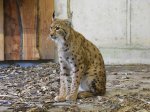Linking Lynx
Safeguarding the Carpathian Lynx Metapopulation
We are a network of experts working on the conservation, monitoring and management of the Carpathian lynx. The long-term goal of the Linking Lynx network is to support the creation of a viable metapopulation of Carpathian lynx in Europe – spanning from the Carpathian Mountains to the Jura, Western Alps and the Dinaric Mountains.

© Laurent Geslin
Working Groups
The Linking Lynx network unites six working groups (sourcing, genetics, health, policy, monitoring & public engagement), as well as planned and ongoing reintroduction and reinforcement projects. A Steering Committee – consisting of the coordinators of each working group and an overall Linking Lynx coordinator – is responsible for agenda setting, cooperation between the working groups and joint communication. Further tasks of the Steering Committee include the organisation of regular Linking Lynx conferences and definition of the funding priorities within working groups.
Sourcing Working Group
The Sourcing Working Group aims to coordinate the use of lynx from different sources such as ex-situ bred lynx, wild captures or orphaned lynx for reintroduction and reinforcement projects.
MoreGenetics Working Group: CElynx Consortium
CElynx is a consortium of scientific institutions working on a harmonized genetic monitoring of Central European lynx populations.
MoreHealth Working Group
The Health Working Group unites experts with different backgrounds dedicated to improving all aspects of lynx health.
MorePolicy Working Group
The Policy Working Group serves as a «clearing house» linking different working levels, from field work, monitoring and research to regional and national administration, authorities and policy makers.
MorePublic Engagement Working Group
The Public Engagement Working Group formalises guidelines for engaging with people, interest groups and key stakeholders.
MoreMonitoring Working Group
Knowledge of the status and distribution of the Carpathian lynx is crucial for management implications and decision making. This group aims to develop the foundation for monitoring the Carpathian lynx in its natural realm.
More





